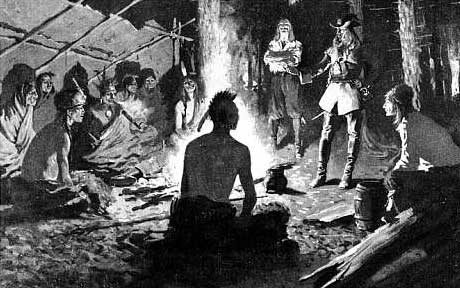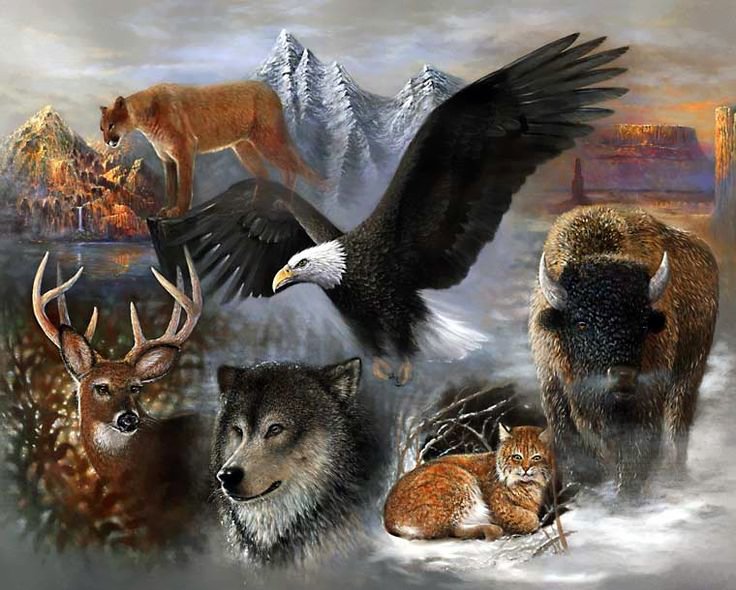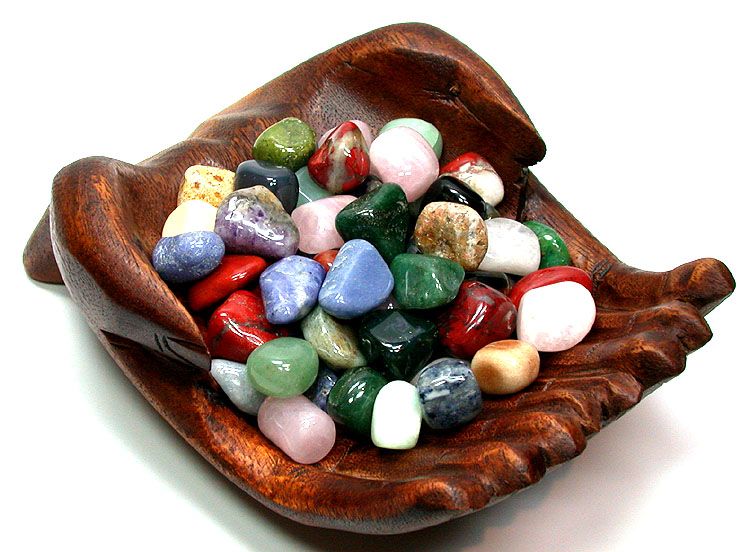Columbus and The Indians Pt 4
- Details
 League of the Iroquois
League of the Iroquois
By the time of Christ and Julius Caesar, there had developed in the Ohio River Valley a culture of so-called Moundbuilders, Indians who constructed thousands of enormous sculptures out of earth, sometimes in the shapes of huge humans, birds, or serpents, sometimes as burial sites, sometimes as fortifications. One of them was 3 1/2 miles long, enclosing 100 acres. These Moundbuilders seem to have been part of a complex trading system of ornaments and weapons from as far off as the Great Lakes, the Far West, and the Gulf of Mexico.
About A.D. 500, as this Moundbuilder culture of the Ohio Valley was beginning to decline, another culture was developing westward, in the valley of the Mississippi, centered on what is now St. Louis. It had an advanced agriculture, included thousands of villages, and also built huge earthen mounds as burial and ceremonial places near a vast Indian metropolis that may have had thirty thousand people. The largest mound was 100 feet high, with a rectangular base larger than that of the Great Pyramid of Egypt. In the city, known as Cahokia, were toolmakers, hide dressers, potters, jewelry makers, weavers, salt makers, copper engravers, and magnificent ceramists. One funeral blanket was made of twelve thousand shell beads.
From the Adirondacks to the Great Lakes, in what is now Pennsylvania and upper New York, lived the most powerful of the northeastern tribes, the League of the Iroquois, which included the Mohawks (People of the Flint), Oneidas (People of the Stone), Onondagas (People of the Mountain), Cayugas (People at the Landing), and Senecas (Great Hill People), thousands of people bound together by a common Iroquois language.
In the vision of the Mohawk chief Iliawatha, the legendary Dekaniwidah spoke to the Iroquois: "We bind ourselves together by taking hold of each other's hands so firmly and forming a circle so strong that if a tree should fall upon it, it could not shake nor break it, so that our people and grandchildren shall remain in the circle in security, peace and happiness."
In the villages of the Iroquois, land was owned in common and worked in common. Hunting was done together, and the catch was divided among the members of the village. Houses were considered common property and were shared by several families. The concept of private ownership of land and homes was foreign to the Iroquois. A French Jesuit priest who encountered them in the 1650s wrote: "No poorhouses are needed among them, because they are neither mendicants nor paupers.. . . Their kindness, humanity and courtesy not only makes them liberal with what they have, but causes them to possess hardly anything except in common."
Women were important and respected in Iroquois society. Families were matrilineal. That is, the family line went down through the female members, whose husbands joined the family, while sons who married then joined their wives' families. Each extended family lived in a "long house." When a woman wanted a divorce, she set her husband's things outside the door.
Families were grouped in clans, and a dozen or more clans might make up a village. The senior women in the village named the men who represented the clans at village and tribal councils. They also named the forty-nine chiefs who were the ruling council for the Five Nation confederacy of the Iroquois. The women attended clan meetings, stood behind the circle of men who spoke and voted, and removed the men from office if they strayed too far from the wishes of the women.
The women tended the crops and took general charge of village affairs while the men were always hunting or fishing. And since they supplied the moccasins and food for warring expeditions, they had some control over military matters. As Gary B. Nash notes in his fascinating study of early America, Red, White, and Black: "Thus power was shared between the sexes and the European idea of male dominancy and female subordination in all things was conspicuously absent in Iroquois society."
Children in Iroquois society, while taught the cultural heritage of their people and solidarity with the tribe, were also taught to be independent, not to submit to overbearing authority. They were taught equality in status and the sharing of possessions. The Iroquois did not use harsh punishment on children; they did not insist on early weaning or early toilet training, but gradually allowed the child to learn self-care.
All of this was in sharp contrast to European values as brought over by the first colonists, a society of rich and poor, controlled by priests, by governors, by male heads of families. For example, the pastor of the Pilgrim colony, John Robinson, thus advised his parishioners how to deal with their children: "And surely there is in all children ... a stubbornness, and stoutness of mind arising from natural pride, which must, in the first place, be broken and beaten down; that so the foundation of their education being laid in humility and tractableness, other virtues may, in their time, be built thereon."
Gary Nash describes Iroquois culture:
No laws and ordinances, sheriffs and constables, judges and juries, or courts or jails-the apparatus of authority in European societies-were to be found in the northeast woodlands prior to European arrival. Yet boundaries of acceptable behavior were firmly set. Though priding themselves on the autonomous individual, the Iroquois maintained a strict sense of right and wrong.... He who stole another's food or acted invalourously in war was "shamed" by his people and ostracized from their company until he had atoned for his actions and demonstrated to their satisfaction that he had morally purified himself.
Not only the Iroquois but other Indian tribes behaved the same way. In 1635, Maryland Indians responded to the governor's demand that if any of them killed an Englishman, the guilty one should be delivered up for punishment according to English law. The Indians said:
It is the manner amongst us Indians, that if any such accident happen, wee doe redeeme the life of a man that is so slaine, with a 100 armes length of Beades and since that you are heere strangers, and come into our Countrey, you should rather conform yourselves to the Customes of our Countrey, than impose yours upon us....
So, Columbus and his successors were not coming into an empty wilderness, but into a world which in some places was as densely populated as Europe itself, where the culture was complex, where human relations were more egalitarian than in Europe, and where the relations among men, women, children, and nature were more beautifully worked out than perhaps any place in the world.
They were people without a written language, but with their own laws, their poetry, their history kept in memory and passed on, in an oral vocabulary more complex than Europe's, accompanied by song, dance, and ceremonial drama. They paid careful attention to the development of personality, intensity of will, independence and flexibility, passion and potency, to their partnership with one another and with nature.
John Collier, an American scholar who lived among Indians in the 1920s and 1930s in the American Southwest, said of their spirit: "Could we make it our own, there would be an eternally inexhaustible earth and a forever lasting peace."
Perhaps there is some romantic mythology in that. But the evidence from European travelers in the sixteenth, seventeenth, and eighteenth centuries, put together recently by an American specialist on Indian life, William Brandon, is overwhelmingly supportive of much of that "myth." Even allowing for the imperfection of myths, it is enough to make us question, for that time and ours, the excuse of progress in the annihilation of races, and the telling of history from the standpoint of the conquerors and leaders of Western civilization.
Excertped from the Book History is a Weapon by Howard Zimm
Source Here
Liked this article? Dive deeper into personal growth and wellness! Check out CrystalWind.ca for spiritual wisdom or explore AromaWorx.ca for natural well-being tips. Spread the positivity—share this with friends on their happiness journey!
Let’s Chat! Drop Your Thoughts Below! ![]()
Latest Articles

Imagine a world of inspiration and healing, free for all—made possible by YOU!
Donate Now—Ignite the Magic at CrystalWind.ca!

Epilepsy - Finding A Cure
Your donation can make a difference!
Help us find a cure – donate now!
Unlock Your Light: Join Lightworkers Worldwide on CrystalWind.ca!
Follow Us!
Featured This Month
Lughnasadh (Lammas) - The Celtic Harvest Fes…
The Celtic harvest festival on August 1st takes its name from the Irish god ... Read more
Lughnasadh Meditation
The Seventh Sabbat of the Wheel is Lughnasadh. Lughnasadh is celebrated on A... Read more
The Season of Lammas
The season of Lammas (also called Lughnasadh) begins on August 1st and conti... Read more
Lammas by The Hedgewitch
Although in the heat of a Mid-western summer it might be difficult to discer... Read more
Lugh - Celtic God Of The Sun
The god Lugh was worshiped in Ireland as a deity of the sun. This connection... Read more












































